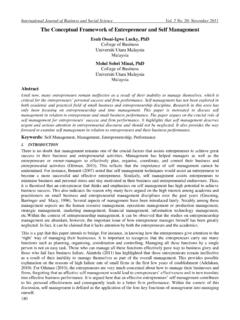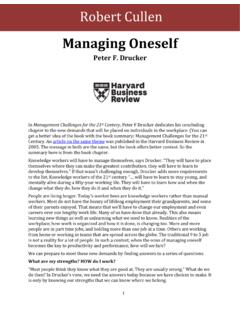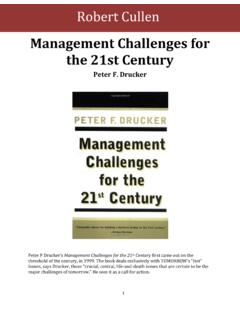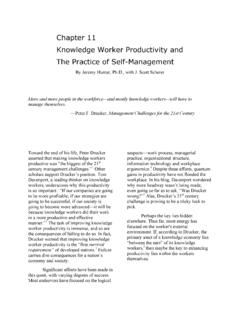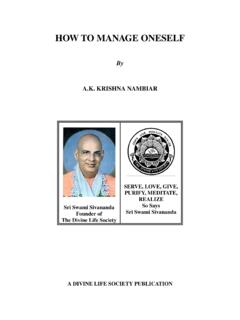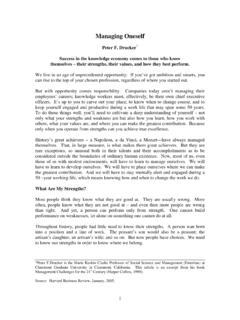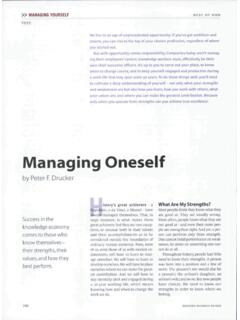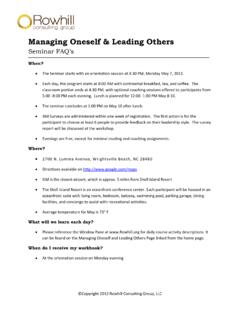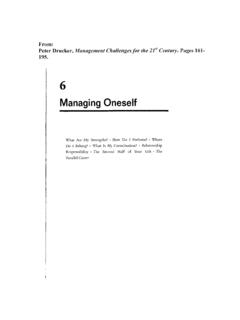Transcription of MANAGING ONESELF - The Olsen Group
1 This very small business book (60 pages) outlines the foundational elements of MANAGING ourselves for success in business and in life. The goal is to place ourselves where we can make the greatest contribution. At first glance you might say that the concepts are not groundbreaking, but as you examine them more carefully you will understand their tremendous we capable of MANAGING ourselves? Our initial reaction to the question is, Of course, I do it every day. The real question is: how well do we manage ourselves for optimum results? In many cases, if we are in a management position, it is easier to manage others to peak performance than ourselves. Why? We are able to determine through trial and error what the strengths and weaknesses of our staff or team members are, but it is harder to do the same for ourselves.
2 This book assists in helping us manage ourselves effectively. Do we really know our own strengths and weaknesses? The author, Drucker, indicates that most people think they know what they are good at but are usually wrong. He also states, They are also wrong about their weaknesses. These two realities put us in positions that limit our success from the onset. This is where the book gets very interesting because Drucker states, The only way to discover your strengths is through feedback analysis. Feedback analysis was invented in the fourteenth century by a German theologian and picked up 150 years later by John Calvin and Ignatius of Loyola (founder of the Jesuit order). Drucker has used this method himself for over 20 years and has found it to be a very effective way of learning your own strengths and weaknesses.
3 Drucker suggests, One should waste as little effort as possible on improving areas of low competence. Understanding and verifying our strengths and weakness allows us to work on improving our strengths. We can then put ourselves where our strengths can produce the best results. Sounds easy right? Well, not exactly. The book highlights certain pitfalls to avoid along the way while we are improving our areas of ONESELFAn Olsen Group Book ReviewBOOK TITLE: MANAGING ONESELF by Peter F. Drucker (Harvard Business Review Classics) Harvard Business School Publishing Corporation. Originally published in Harvard Business Review in March 1999 and January This is my personal favorite quote: Discover where intellectual arrogance is causing disabling ignorance and overcome it. We have all seen this phenomenon, where people with great expertise in one area believe they are equally competent in a completely different area.
4 This is often referred to as blind spots because in most instances we do not realize we think or act this following sections of the book help us understand critical elements in improving our areas of strength. The book starts with a discussion of the ways in which a person performs best, which is determined by understanding our personality traits. Drucker does not give specific detail on how to determine our personality traits, but there are a number of proven personality tests that are available. The second critical element is determining how we learn. Do we learn by listening (auditory), reading (visual) or by doing (kinesthetic)? These are the most common and well-known learning modalities, but Drucker introduces two lesser-known methods.
5 Apparently, it has been discovered that some individuals learn through writing, like Churchill and Beethoven. Others learn by hearing themselves talk. This brings new meaning to the saying, Some people like to hear themselves speak. Apparently, in some cases the speaker is learning. Drucker indicates that, Of all the important pieces of self-knowledge, understanding how you learn is the easiest to acquire. However, his findings show that few act on this we understand our strengths and how we learn, we must also ask ourselves the following in order to manage ourselves I work well with people, or am I a loner? In what relationship? I produce results as a decision maker or as an adviser? I perform well under stress, or do I need a highly structured and predictable environment? I work best in a big organization or a small one?
6 Are my values? What kind of person do I want to see in the mirror in the morning? do I belong? should I contribute? What is my vision and plan?If you respond that you do work well with people, then you must take Responsibility for Relationships. The aspects of these relationships include knowing the strengths, weaknesses, values and how to get work done. The second is taking the responsibility to communicate this information concerning yourself to your , the author makes a compelling argument for thinking about the second half of your life during the first half. The premise is that most of us are knowledge workers and will be able to work for over 40 years. He indicates that most executives reach the peak of their business careers at age 45 after working for 20 years.
7 In many cases, they are not learning and deriving satisfaction from their employment. As a result, many executives look to make a change in careers at this point. If we begin thinking about this possibility early in our life, we will have ample time to contemplate and plan for our second careers.
